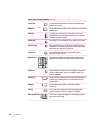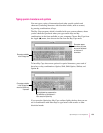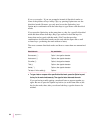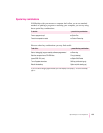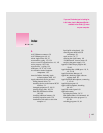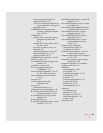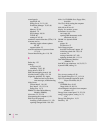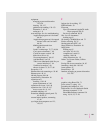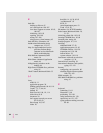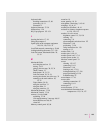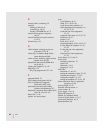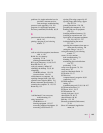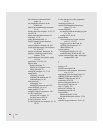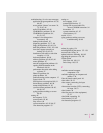
control panels
AppleTalk 60
Energy Saver 21–22, 130
Extensions Manager 78, 85, 86,
94, 97
Memory 85, 90
Monitors 79
PC Exchange 89, 90
TCP/IP 60
turning off 85, 86
cumulative trauma disorders (CTDs) 124
customer service
obtaining Apple software updates
98–102
support hotline 25
custom installation of system software
117–119
Custom Install dialog box 118, 120
D
Delete key 152
desktop
At Ease and 92
rebuilding 78, 83, 89
device drivers, SCSI 57
DHCP bootstrapping protocol 60
diacritical marks, typing 153–154
diagnosing problems. See Apple-
authorized service providers;
error messages; troubleshooting
dialog boxes
Custom Install 118, 120
Easy Install 112, 115–116
Energy Star 14, 21
DIMMs. See Dual Inline Memory
Modules (DIMMs)
dim screen 22, 79, 130
disconnecting the computer 6, 128
Disk First Aid program
installing system software 111, 120
repairing damaged disks 108–109
disks. See CD-ROM discs; floppy disks;
hard disk
Disk Tools disk, starting the computer
from 104
disk with an X icon 81
display. See monitor; screen
documents. See also files
can’t open 89
opening DOS documents on the
Macintosh 89, 90
DRAM. See dynamic RAM
drivers
printer 98
SCSI device 57
Drive Setup program
hard disk icon doesn’t appear 82
initializing a hard disk 103, 105
overview 61
testing a hard disk 107–108
updating the hard disk 111, 114
Dual Inline Memory Modules
(DIMMs) 58
dual RCA-type connectors 44, 50, 52, 53
dynamic RAM, adding 58
E
Easy Access, turning off 88
Easy Install dialog box 112, 115–116
Eject CD command (AppleCD Audio
Player File menu) 69, 92
ejecting
CD-ROM discs 69, 92
floppy disks 83–84, 134
electromagnetic emissions from computer
monitors 127
Energy Saver control panel 21–22, 130
energy-saving options, setting 14, 21,
130
Energy Star dialog box 14, 21
Enter key 152
160
Index



